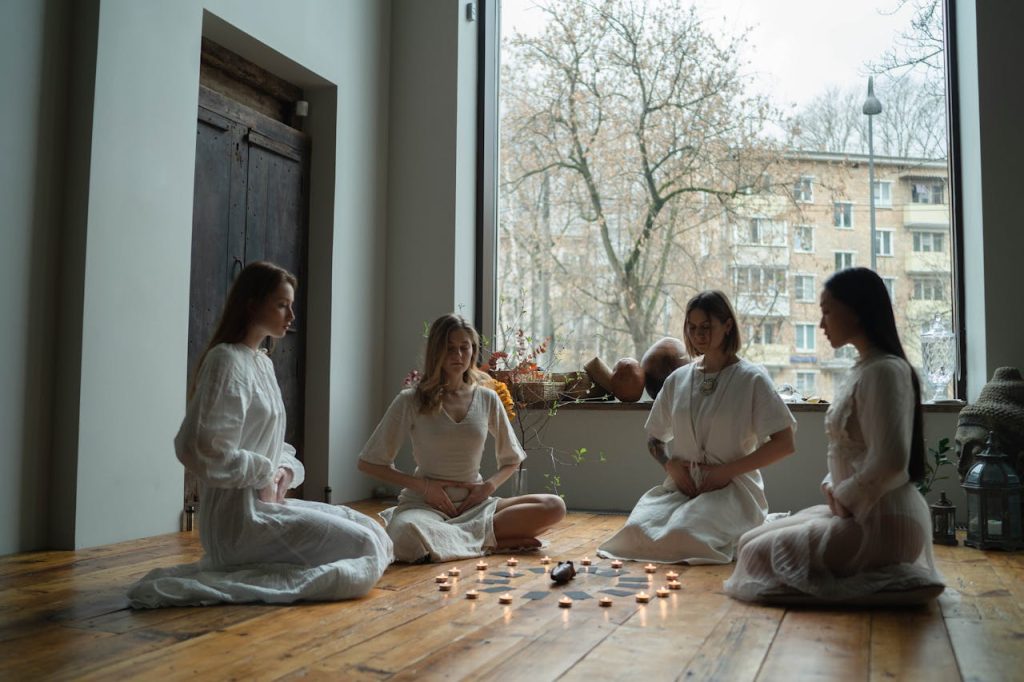How to Meditate: A Step-by-Step Guide for Beginners
Table of Contents

Learn how to meditate with simple, effective techniques to reduce stress, improve focus, and enhance your overall well-being. Start your mindfulness journey today.
Discover the power of meditation with this step-by-step meditation guide. Learn techniques, benefits, and tips for building a consistent practice that enhances mindfulness, reduces stress, and promotes inner peace.
Introduction to Meditation
Meditation is a transformative practice that helps cultivate mindfulness, inner peace, and self-awareness. It’s important to note that while meditation can be beneficial for many, it’s not a substitute for professional treatment for specific mental health conditions. If you have concerns about your mental health, it’s best to consult a healthcare professional before starting a meditation practice. Whether you’re looking to reduce stress, improve focus, or achieve emotional balance, meditation is a simple yet powerful tool to enhance your well-being. The best part? Anyone can meditate! In this guide, we’ll walk you through the essential steps of meditating, different techniques, and tips to make meditation a consistent part of your life.

Why Should You Meditate?
Before diving into the how-to, let’s explore some key benefits of meditation:
- Reduces Stress and Anxiety: Meditation helps lower cortisol levels, promoting relaxation and calmness.
- Enhances Focus and Concentration: Regular practice strengthens your ability to stay present and engaged.
- Improves Emotional Health: Mindfulness meditation fosters greater self-awareness and emotional resilience.
- Promotes Better Sleep: Meditation techniques like deep breathing and body scanning help relax the nervous system, aiding sleep quality.
Boosts Overall Well-being: Meditation has numerous health benefits, from lowering blood pressure to increasing feelings of happiness. It can also improve your immune system, enhance your emotional health, and even boost your creativity and problem-solving skills. Regular meditation can lead to a more balanced and fulfilling life.Now that we understand why meditation is beneficial, let’s learn how to start!
Step-by-Step Guide: How to Meditate
1. Find a Quiet and Comfortable Space
To begin meditation, choose a peaceful location where you won’t be disturbed. It could be a corner in your home, a garden, or a quiet room. Ensure that the space is clean, uncluttered, and comfortable.
2. Choose a Comfortable Sitting Position
You don’t need to sit in a full lotus position to meditate. The key is to find a posture that keeps your spine straight and allows you to remain still and relaxed. You can sit:
- Cross-legged on a cushion
- On a chair with your feet flat on the floor
- Kneeling on a meditation bench
Keep your hands resting gently on your lap or knees.
3. Close Your Eyes and Relax
Softly close your eyes to limit distractions and turn your focus inward. Relax your facial muscles, shoulders, and jaw. If you prefer, you can keep your eyes slightly open with a soft gaze.
4. Focus on Your Breath
One of the most straightforward meditation techniques is breath awareness. Gently bring your attention to your natural breathing pattern without trying to control it. Observe the inhale and exhale, noticing the sensations of air passing through your nostrils and filling your lungs.
Tip: If your mind wanders, gently bring your focus back to your breath without judgment.
5. Acknowledge and Let Go of Thoughts
It’s entirely normal for thoughts to arise during meditation. Instead of resisting them, acknowledge their presence and let them pass like clouds drifting in the sky. Then, bring your focus back to your breath or chosen point of awareness.
6. Use a Mantra or Affirmation (Optional)
A mantra is a word or phrase you can repeat to maintain focus. Common examples include:
- “Om” – A traditional sound used in meditation
- “I am calm and at peace.”
- “Breathe in calm; breathe out stress”
Repeating a mantra can help anchor your mind and deepen your meditation practice.
7. Start with Short Sessions
Meditating for 5-10 minutes is a great starting point for beginners. As you grow comfortable, gradually increase your practice to 15-30 minutes per session.
8. Gently End Your Meditation
When you’re ready to finish, slowly bring awareness back to your surroundings. Wiggle your fingers and toes, stretch lightly, and open your eyes. Take a few moments to appreciate the sense of calm before resuming your day.
Different Types of Meditation Techniques
Meditation is not a one-size-fits-all practice. It’s a journey of self-discovery and inner peace that you can tailor to your needs. Here are some popular types to explore, each offering a unique approach to mindfulness and well-being:
1. Mindfulness Meditation
Originating from Buddhist teachings, this practice involves observing thoughts, feelings, and sensations without judgment. It helps cultivate present-moment awareness and emotional balance.
2. Guided Meditation
A meditation teacher or an audio recording guides you through visualization exercises, breathing techniques, and relaxation prompts, making it ideal for beginners.
3. Loving-Kindness Meditation (Metta Meditation)
This practice focuses on cultivating compassion and love for yourself and others. You silently repeat phrases such as, “May I be happy, may I be healthy, may I be at peace.”
4. Body Scan Meditation
A systematic practice of bringing awareness to different body parts, releasing tension, and promoting relaxation.
5. Transcendental Meditation
This technique involves silently repeating a specific mantra to help the mind transcend ordinary thoughts and reach a state of deep rest.

Tips for Building a Consistent Meditation Practice
- Set a Regular Time: Meditating simultaneously each day helps establish a routine.
- Create a Dedicated Meditation Space: Having a special spot for meditation makes it easier to stay consistent.
- Use Meditation Apps: Apps like Headspace, Calm, and Insight Timer offer guided sessions to support your practice.
- Be Patient and Kind to Yourself: Some days will be easier than others. The key is to stay consistent without self-judgment.
- Combine Meditation with Daily Activities: Practice mindfulness while walking, eating, or even doing household chores.
It’s important to remember that meditation is a journey, and like any journey, it has its challenges. You’re not alone in these experiences, and there are ways to overcome them. Let’s explore some common challenges and how to address them:”I Can’t Stop Thinking!”
It’s natural for thoughts to arise. Instead of fighting them, acknowledge and gently redirect your focus to your breath.
“I Don’t Have Time to Meditate”
Start with just 5 minutes a day. Even short sessions can have profound benefits.
“I Keep Falling Asleep”
Try meditating in the morning or sitting up straight instead of lying down.
Final Thoughts
Meditation is a journey of self-discovery and inner peace. Following these simple steps and exploring different techniques can build a practice that enriches your life. Whether you’re meditating for stress relief, better focus, or emotional well-being, consistency and self-compassion are key.
Are you ready to begin your meditation journey? Start today with just a few mindful breaths, and experience the transformative power of meditation in your daily life!

Meditation FAQs
Everything You Need to Know to Get Started
The word “meditation” literally means thinking in the same direction. Hence, meditation teaches the mind to stay focused and return to thoughts that we have no control over, thus promoting mental clarity, emotional calmness, and a peaceful state of mind.
Regular meditation can bring about immediate benefits such as stress reduction, as well as long-term improvements in focus, emotional wellness, and overall well-being.
Take the first 5-10 minutes in a quiet place. Find a comfortable position, close your eyes, and concentrate on your breath, guiding your mind back when it drifts.
The best time to meditate is when it fits into your schedule. While many prefer the morning, you can choose a time that works best for you. Headspace
Find a space where you can devote your time to performing the exercises, such as a quiet spot in your home free from distractions.
Promote relaxed clothing that does not limit mobility. Remove tight clothes so as to relax. Headspace
Begin by doing 5-10 minutes a day and increase the time gradually as you get more comfortable. Dummies – Learning Made Easy
Numerous types of meditation exist, each with its unique approach and benefits. These include mindfulness meditation, focused attention meditation, loving-kindness meditation, and body scan meditation. Exploring these can add variety and depth to your practice. Learn more.
Sitting is recommended to stay awake, but lying down is also acceptable, especially if sitting is not comfortable. Learn more.
It’s entirely natural for your mind to wander during meditation. When this happens, guide your attention back to your chosen anchor point, such as your breath.
Not at all; sit in any relaxed, comfortable position that allows you to keep your back straight.
Meditation has been demonstrated to alleviate symptoms of anxiety and depression as it promotes relaxation and a state of present-moment awareness.
Correct your posture, take support with cushions, and do gentle stretches before meditating.
The most common misconception about meditation is that it requires a teacher.
Although not required, a teacher can provide structure and the support you’ll recommend when you start, and meditation apps can help you, too.
Some benefits, like immediate stress reduction, can be experienced right after a session, while others, like improved focus, may take weeks of consistent practice to develop fully.
- Home
- Getting Started with Meditation
- Explore Powerful Meditation Methods
- A Beginner’s Guide to Inner Peace
- Why Meditation Can Transform Your Life
- Mindfulness & Meditation Resources
Retreats
Top 5 Meditation Sites You Need to Know for Inner Peace and Focus
🧘♂️ 1. Headspace
Website: www.headspace.com
- One of the most popular platforms for guided meditation and mindfulness.
- Offers structured programs for stress, sleep, focus, and anxiety.
- Includes a user-friendly app with animations and expert tips.
🧘♀️ 2. Calm
Website: www.calm.com
- Known for its soothing interface and soundscapes.
- It offers sleep stories, breathing exercises, and meditation tracks.
- Ideal for both beginners and advanced users.
🧘 3. Insight Timer
Website: www.insighttimer.com
- It offers the world's most extensive free library of guided meditations.
- It features thousands of teachers, live sessions, and music for mindfulness.
- Great for variety and exploring different meditation styles.
🧘♂️ 4. The Chopra Center
Website: www.chopra.com
- Founded by Deepak Chopra, this site blends meditation with Ayurvedic wellness.
- Offers guided sessions, spiritual growth content, and wellness courses.
- Well-respected in both scientific and spiritual wellness circles.
🧘♀️ 5. UCLA Mindful Awareness Research Center
Website: www.uclahealth.org/marc
- A research-based meditation resource from UCLA.
- Offers free guided meditations and mindfulness classes.
- It is backed by neuroscience and is ideal for users looking for evidence-based mindfulness.
